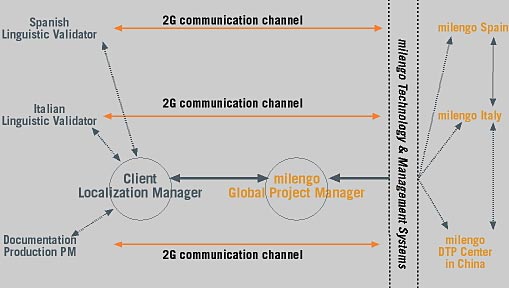 |
 |
 |
| Home | More Articles | Join as a Member! | Post Your Job - Free! | All Translation Agencies |
|
|||||||
|
|
Switching Off Autopilot: The Power of Choice
An
innovative business model takes off in the localization
industry? Yet, generally speaking, consolidation is not always entirely beneficial to clients. With buyers demanding more and paying less, only the most dynamic companies with the right product and service mix can satiate their long-term needs. Lionbridge's purchase of Bowne Global Solutions reduces the options buyers can choose from to a small group of global localization vendors who can now easily exert their market dominance. Of course, buyers can also choose to work with a combination of smaller agencies that fight over the contracts but which cannot always offer the services, competencies or resources that a one-stop vendor would. The goal of this article is not to address the fears and impacts associated with market consolidation in our industry. Instead, it will address an important question buyers may be asking themselves as they develop future localization planning: Are there other solutions or providers besides these few major players, or am I forced to choose from this handful? The
answer is yes: the localization alliance model. The obvious difference between a localization alliance and an MLV model is the fact that the alliance is a group of financially independent companies, each located in a different country, and which, by pooling their resources together, integrate and structure their service offer. On the other hand, an MLV is a single entity that has to maintain a global production and sales infrastructure. Each alliance member is not only selected by its best blend of language skills, technology investment and localization industry experience, but also for its ability to adhere to the alliance's requirements and expectations. This new business model commonly stipulates what these expectations are, such as monthly volume, quality and communication requirements. In doing so, the alliance is able to commit to a high standard of professionalism. An alliance model also departs from the 1st Generation subcontracting model due to the following facts:
Therefore, the client can expect that quality will remain consistent because the same vendor is always performing the work. As a result, the global project manager (GPM) of the alliance and each member involved in the project develop a unique and long-lasting relationship with the client, one built on trust and which fosters the GPM's understanding of the client's specific requirements. Clients see not just price discounts, but also a streamlined production process that improves the time-to-market results with lower client-side management conditions. Sharing
Resources  A graphic representation of how the 2G Localization Model works The localization and airline industry, interestingly enough, share many similarities. Twenty years ago, airline companies confronted the challenge that localization companies now face in unmasking ways to improve and expand their service levels and the options they offer to clients, all at a lower cost. Today's frequent flyers expect to be taken anywhere in the world with the same high level of commitment to quality, service and safety. Twenty years ago, this was not the case. Shortly after the deregulation of the US airline industry in the late 1980s, so-called code-sharing alliances between a US airline and a European national carrier quickly took off. This partnership allows one airline to sell seats on its partner plane as if they were its own, allowing it to expand its route network without adding any aircrafts. This further allows passengers to check in at the airport and obtain their boarding passes for their entire flight, simplifying the ticketing process.
In an environment where no competition exists, an alliance
member's own business is strengthened by the resources
and facilities of its partners. Members can develop agreements
that allow them to share, manage or jointly advance the
operation, management and sales/marketing resources that
would be too expensive for one company to manage by itself.
A Spanish airline, for example, could use the maintenance
facility of its US partner while servicing its customer
base in America , and vice versa. Both companies could
also combine the marketing activities for the route flown
in the two countries and expand their frequent flyer programs
and benefits to cover Spanish and US passengers. Frequent
flyer programs, while not widely used in the localization
industry, are among the projects to be designed and implemented
by milengo in the near future. The localization market will continue to develop to meet IT client's ever-evolving needs. Some vendors have made the decision to integrate proprietary technology into their workflow. Others feel that continued specialization in certain segments of the industry is their best move, while still others have thought that an alliance is the best way to provide clients with a reasonable alternative to their localization needs. Because each client's requirements are not universal in our market, an alliance model may not be an appropriate solution for certain IT companies. However, the option to choose from a range of solutions, instead of only a handful shifts the control back from autopilot to pilot. This is what will allow the new alliance model to take off.
Adam Blau is responsible for managing milengo's global operations as well as its sales and marketing activities in North America and Europe. Having joined the alliance during its conceptual phase, he currently leads members in the development of customized localization solutions in their respective regions and helps strengthen relationships with milengo's international clients.
E-mail this article to your colleague! Need more translation jobs? Click here! Translation agencies are welcome to register here - Free! Freelance translators are welcome to register here - Free! |
|
|
Legal Disclaimer Site Map |